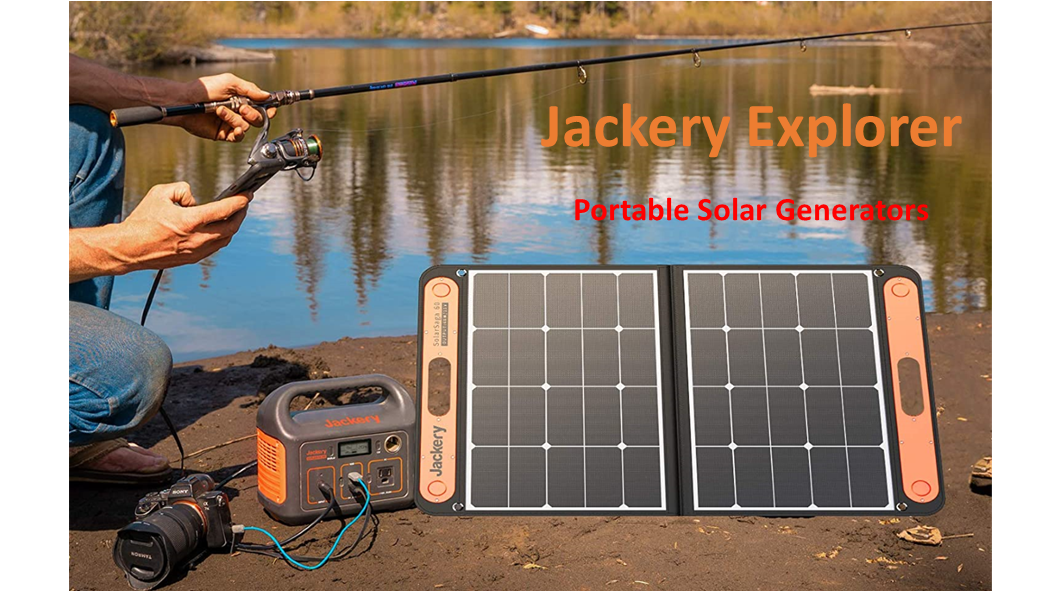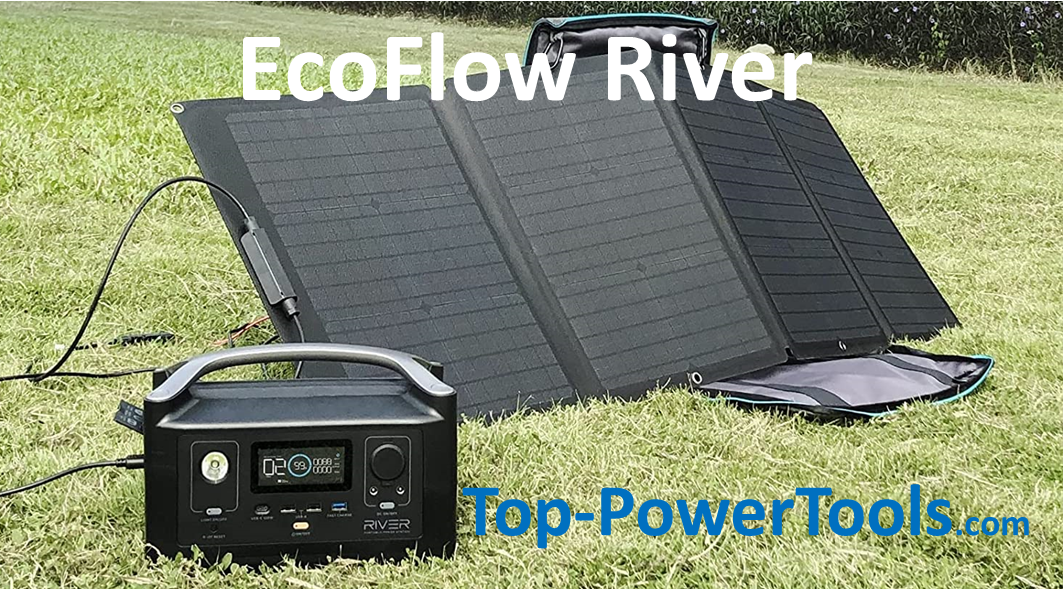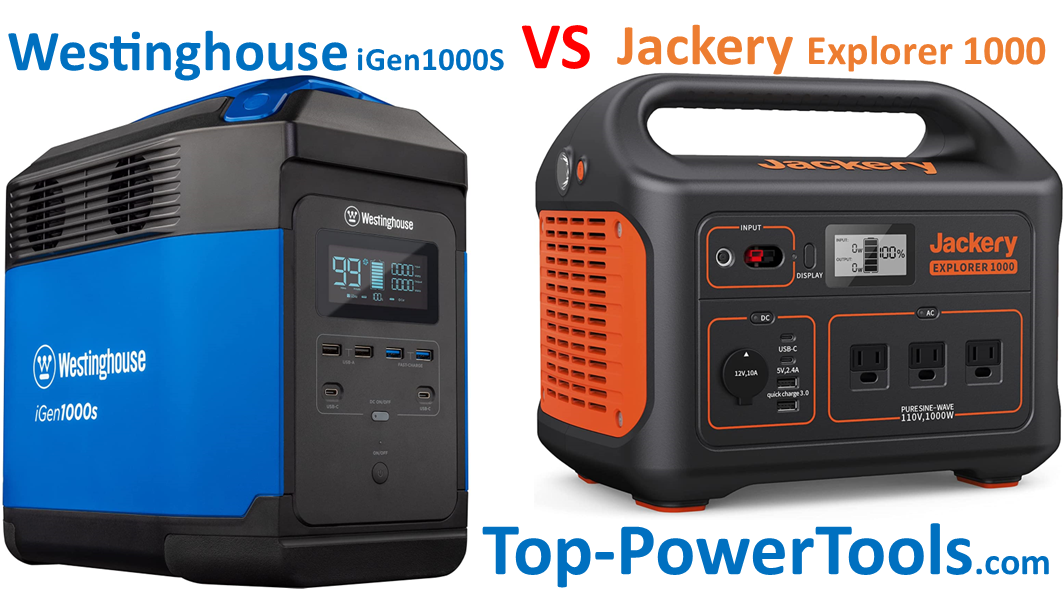It came as little surprise to me that portable power stations, or solar generators, are best-sellers in the outdoor power market. Once the domain of gas-powered generators, battery power packs with an AC inverter are now the most popular choice for camping and home backup power.
If you’ve been shopping around for a portable power station, you’d have noticed there is no shortage of options. Though one brand dominates the market. An observation of the best-selling generators on Amazon, reveals that Jackery portable power stations are top of the list. Beating traditional best-selling gas generators. There are a number of portable power station brands on this list, scattered amongst the gas generators; but none feature as prominently as the Jackery Explorer series.
Why are Jackery portable power stations so popular?
Goal Zero and Jackery were among the first to cotton onto the great potential of portable power stations. The idea of clean, silent, portable power is fantastic. Add to this, multiple charging options (120 VAC, 12 VDC car charger, or solar), and you have a winning combination.
I have always believed that the Goal Zero Yeti range of solar generators is the ideal choice. For one thing, they have a much more extensive range, from the small (extremely portable) Goal Zero Yeti 200X to the immensely powerful 6KW Goal Zero Yeti 6000X. The top Yeti models have the watts to supply your home, quite comfortably, for several days, thanks to chainable additional battery packs. This makes the Goal Zero Yeti 3000X and 6000X worthy, much cheaper, rivals to the highly acclaimed Tesla Powerwall. In my opinion, a much better deal.
Now that I’ve hyped up the Goal Zero portable power stations, what about Jackery? After all, this is a review of Jackery portable power stations, not Goal Zero. I think Goal Zero Yeti dominates the high-watt solar generator market. Their products are also the most robust. This does, however, make them more expensive than Jackery Explorer portable power stations.

The reason why Jackery is the number choice for portable battery-powered inverters is, quite simply, exceptional value for money. If you’re looking at the real el-cheapos, like the Eco-Worthy 84 WH portable power station, there can be no comparison. These really cheap, gimmicky, solar generators are, in my opinion, a real waste of money. This is not the case when you buy a Jackery portable power station.
While not quite as tough as Goal Zero, Jackery Explorers are high-quality products. In terms of high-spec technology and great build quality, Jackery is as close as you’ll get to the more rugged Yeti portable power stations. Where it really counts, high-quality battery and inverter technology, Jackery is as good as any of the best in the business. Just a good deal cheaper than high-end competitors. Really great, common sense, value for money. Who can argue with that?
If you’re looking at buck per watt, or buck per watt-hour battery storage, Jackery Explorer products are (in real terms) half the price of their Yeti counterparts. I can’t say, in all earnest, the Yeti power stations are twice as tough as the Explorer models, which are on the higher end of the quality scale when compared to most others. Again, the emphasis is on genuine value for money. I think Jackery is the outright winner in this department.
There are a bunch of Jackery Explorer models, sharing many common traits. The real difference between the various model numbers is the amount of battery storage and the output capacity for the inverter.
I’ll be providing a basic overview of the Jackery models. In these brief reviews, I’ll give the model specs and where they may be most useful. This should help you determine the best Jackery portable power station for your needs. I know there is a massive demand for portable battery power stations for CPAP. There are also a myriad of other uses for these versatile machines. I’ll be considering all of this.
Before scrutinizing the models that you can choose from, I would like to provide a more general discussion on the commonalities between all Jackery Explorer portable stations. This should explain why these are such popular, and exceptional, solar generators.
Lithium-ion Battery technology
In order to compare portable power station brands, you need to have a basic understanding of batteries. After all, it is the battery that lies at the heart of the device. You may still find cheap models that use Nickel-Cadmium (Ni-Cd) batteries. These machines may be inexpensive, but not the most effective. Lithium-ion batteries are the best and this is the technology preferred by most top brands.
There are many types of lithium batteries and some are better than others. Lithium Cobalt Oxide (LCO) is the cheapest, usually found in low-power devices, like flashlights and cell phones. Power tool and portable power station manufacturers will often use these cheaper variants to cut costs. This is a little deceptive. They will advertise it as being a lithium-ion battery-powered device, assuming that we, the consumers, believe that all Li-ion batteries are equal. This is why I’m setting the record straight. It’s important to know what type of lithium-ion battery you’re getting for your money.
Understandably, engineers need to weigh up the odds between battery performance and cost. A cost-effective battery is important. You don’t need the same caliber of battery for a portable power station as you would for an electric vehicle, or mass power storage, like a commercial solar generating plant. The applications are different. High-power lithium batteries need to handle huge discharge and bulk charging at a high amperage. This type of battery would actually be a waste of money for something like a portable power station.
Now for the big question: what is the best battery for a portable power station?
The answer is Lithium Nickel Manganese Cobalt Oxide (Li-ion NMC). The cost vs specific energy is perfect for an application like portable power stations. These batteries are stable, lightweight, and incredibly efficient. They also last longer than the cheaper lithium batteries, with a lifespan of up to 2,000 cycles. A battery cycle is the number of times it can be charged and discharged before it is no longer viable.
Though, even all Li-ion NMC batteries can differ. Cobalt is a rare and expensive element. To make the battery cheaper, many manufacturers reduce the amount of cobalt used in their Li-ion NMC batteries, using more nickel which is cheaper.
Unfortunately, there is no way of telling the ratio of nickel, manganese, and cobalt used in the battery you buy. Manufacturers are not required to specify the exact composition of the battery. It can be assumed that most power equipment manufacturers are using less cobalt as the application does not require the same standard as high-powered equipment, like cars.
All Jackery Explorer portable power stations are fitted with Li-ion NMC batteries. Judging by the rated life of over 500 cycles up to 80%, they are using less cobalt in their batteries. Though I should also explain how battery manufacturers evaluate the lifespan of the battery.
Battery life is totally unpredictable. It depends on operating conditions like temperature and the depth of discharge for each cycle.
When we see the spec ≥500 cycles to 80%, what does it actually mean?
Because of the unpredictable nature of battery life, specified cycles have to give you the minimum expected lifespan. Interpreting the Jackery battery spec provides an indication of what to expect. This means that after 500 cycles from full charge to a discharge of around 80% of the maximum battery capacity, the battery will provide approximately 80% of the time it would when new.
Battery lifespan (up to 80%) will usually be better than this after 500 cycles. This does not mean the battery is depleted after 500 cycles, it just won’t be performing at full capacity. If the battery was providing 4-hours when new, it will be providing around 3-hours and 40-minutes after 500 cycles. You can obviously continue using the battery for a long time after this. Your usable time will gradually reduce over time.
Battery Management System
A battery management system (BMS) is essential in ensuring battery safety, performance, and lifespan. Like most portable power stations, the Jackery Explorer has an electronic management system that monitors and controls the battery during charge and discharge cycles.
The most important functions would be to prevent overcharging and short circuit. This eliminates the risk of fire and damage to the battery. Battery temperature, especially when charging, is important as high charging temperature reduces battery life. The battery system should also shut down when the battery reaches 80% discharge. Low battery (below 20%) will damage the battery.
The Jackery battery power station constantly monitors the battery level, displaying it on an LCD screen. When the battery starts to run low, you will receive a warning. Once the battery is too low, the system will shut down and you have to recharge the battery before you can continue using the power station.
All this ensures that you get the maximum life and best performance from your lithium-ion battery. Not to mention the ever-important safety aspect.
Pure Sine Wave Inverter
To provide 120V AC power from a DC battery, portable power stations use an inverter. This is an electronic device that converts DC to AC electricity.
There are three types of inverters:
- Square sine wave.
- Modified (step square) sine wave.
- True sine wave.
Square sine wave inverters are seldom used as they are not at all efficient. There are many AC devices that won’t function using a square sine wave. A modified sine wave inverter uses several square steps to improve performance and allow for most appliances to function normally. They are not the best but are an improvement on square sine wave inverters.
Pure, or true sine wave inverters create a natural curved sine wave. The same as the power grid. These are the most expensive inverters and are the best. They are more efficient and supply a stable, monitored supply that is better than the power you’d get from a conventional generator. The sine wave is usually cleaner, and therefore, better than the utility power in our homes.
Pure sine wave inverters are considered the best power supply for electronic equipment. Total Harmonic Distortion can be less than 1%. Though most pure sine wave inverters, like those used in the Jackery portable power stations, are rated at less than 3% THD. Considering that a gas generator can exceed 25% THD, and the power in your home is often above 10%, this is a really great achievement.
Outlets and Functions
The Jackery explorer range of portable power stations has a comprehensive control panel with a great digital display. The number of AC outlets and the type of USB ports will vary for different models.
They all have at least 1 X 110V AC pure sine wave (inverter supplied) outlet, a 12VDC outlet, and USB ports. The charger input is the same for all models, but the charging amperage is higher on those with larger batteries.
The DC charger inputs can be supplied by:
- 120V AC wall charger (supplied with all models).
- 12 VDC car charger (supplied with all models).
- Solar panel/s (sold separately or as part of a complete solar kit).
The digital display is common to all Jackery Explorer models, providing a large battery icon and battery level expressed as a percentage of the available battery capacity. Input and output wattage is also displayed. The display can be switched off to save on battery power consumption.
Protection from short circuit and overload at the outlets is managed electronically. The unit will shut down if the output is unsafe and reset when normal output is restored.
Jackery Explorer power stations also have a built-in LED flashlight for a bit of extra convenience during an outage or when camping.
Solar Power

All Jackery Explorer portable power stations use a Maximum Power Point Tracking (MMPT) solar charge controller. This is the most efficient use of solar energy to charge a battery.
The voltage from a solar panel changes constantly, depending on the amount of sunlight it receives. Typically, closed circuit solar voltage (for a nominal 12V panel) is anywhere between 10V and 18V, possibly more. Open circuit voltage can be much higher. Though this is when the battery is not being charged and is, therefore, irrelevant to this discussion.
A 12V battery charges between 10.5 to 14.4 volts. What happens to the extra volts when the solar panel is generating 18V? With a cheap solar charger, the extra watts are simply lost. The charger will keep the volts at around 13V – 14V until the battery reaches full charge. MPPT chargers use electronic monitoring to match the voltage from the panel what the battery requires. When the voltage from the solar panel is higher than the battery requirement, it will lower the volts and increase the amperage to provide more charge at the required voltage. MPPT chargers make use of every watt produced by the solar panel, making them much more efficient.
Jackery recommends that you use SolarSaga photovoltaic (PV) panels. These are pretty good quality solar panels. Not too expensive, and wonderfully portable. Though you can use just about any solar panel with a nominal 12V rating, provided the wattage does not exceed the charge input range for the model you’re using.
Jackery Explorer Models
There are five models available in the Jackery Explorer lineup, ranging from the really compact Explorer 160 to the most powerful in the range – Jackery Explorer 1000. The model numbers indicate battery storage capacity. The inverter output wattage also increases as you go higher up the range.
I’ll provide a basic overview of the technical specifications for each Jackery Explorer model and the type of application each model is best suited.
Jackery Explorer 160
Tech Specs & Features:
- Battery: Li-NMC – 167WH; 11.6AH @ 14.4V
- Pure sine wave inverter: 110V 60HZ: 150W surge capacity; 100W running capacity.
- Output ports: 1 X 110V AC outlet; 1 X USB C; 2 X USB A; 12VDC (7A) car socket.
- 12V – 30V DC charger input, maximum 42W.
- Charge times: AC wall charger: 5-hours; 12V car charger: 5-hours; 60W solar panel: 4.5-hours.
- Weight: 3.97 LBS.
- Dimensions: 7.4” X 4.5” X 6.7”.
Typical Battery Runtimes:
- Drone (60W): 3 charges. ● Laptop (60W): 10-hours with fully charged laptop battery ● CPAP (30W): 5-hours ● Smartphone (18W): 16 charges.
Overview:
The Jackery Explorer 160 is no bigger than a portable radio and weighs less than 4-pounds. The optional SolarSaga 60W panel also folds to be about the size of a book. This is its main attraction.
This exceptionally portable power station is the ideal companion for backpackers and other outdoor activities, like fishing trips and tailgating. The downside is not much inverter power or battery storage. A CPAP, for example, won’t last an entire night on one battery charge, roughly hours is the best you can expect.
The Jackery Explorer 160 is fantastic for keeping low-powered devices charged when you head off-grid. Your phone and GPS will always have power and you have a small lightweight solar panel kit to keep you powered up as long the sun shines.
Download Jackery Explorer Owner Manual [PDF]
Jackery Explorer 240
Tech Specs & Features:
- Battery: Li-NMC – 240 WH; 16.8AH @ 14.4V
- Pure sine wave inverter: 110V 60HZ: 200W surge capacity; 400W running capacity.
- Output ports: 1 X 110V AC outlet; 2 X USB A; 12VDC (10A) car socket.
- 12V – 30V DC charger input, maximum 65W.
- Charge times: AC wall charger: 5.5-hours; 12V car charger: 5.5-hours; 60W solar panel: 6-hours.
- Weight: 6.6 LBS.
- Dimensions: 9.05” X 5.24” X 7.87”.
Typical Battery Runtimes:
- Drone (60W): 4 charges. ● Laptop (60W): 3.5 charges ● CPAP (30W): 8-hours ● Smartphone (18W): 24 charges ● TV (60W): 3-hours.
Overview:
The Jackery Explorer 240 portable power station is a little larger than the Explorer 160, yet still compact and lightweight enough for hiking and fishing trips. It has the same option for the wonderfully portable SolarSaga 60W solar panel kit.
Despite being almost as portable, the Explorer provides better battery time and a larger inverter. The 240WH battery should provide enough power for a full night (8-hours) supplying a CPAP. At just under $200, this is the most popular Jackery portable power station. In fact, it’s the most popular solar generator on the market.
The Jackery Explorer 240 has been rated by most review sites as the best portable power station for the outdoors. For the most part, I can agree. It’s wonderfully affordable, yet robust and technically brilliant.
Jackery Explorer 300
Tech Specs & Features:
- Battery: Li-NMC – 293 WH; 20.4AH @ 14.4V
- Pure sine wave inverter: 110V 60HZ: 500W surge capacity; 300W running capacity.
- Output ports: 2 X 110V AC outlet; 1 X USB A; 1 X USB QC 3.0; 1 X USB C (PD); 12VDC (10A) car socket.
- 12V – 30V DC charger input, maximum 100W.
- Charge times: AC wall charger: 5-hours; 12V car charger: 5-hours; 100W solar panel: 5.5-hours; USB PD input: 5.5-hours.
- Weight: 7.1 LBS.
- Dimensions: 9.1” X 5.2” X 7.8”.
Typical Battery Runtimes:
- Drone (60W): 5.5 charges. ● Laptop (60W): 4 charges ● CPAP (30W): 9.7-hours ● Smartphone (18W): 30 charges ● TV (60W): 4.5-hours.
Overview:
Many may see the Jackery Explorer 300 as the perfect solution. It has the more advanced features, found on the top-of-the-range Explorer 1000, like USB 3.0, and a USB C PD input/output. It obviously has a more powerful 300W/500W inverter and a larger 293WH battery. Yet the Explorer 300 is only a fraction of an inch larger in height, width, and length, when compared to the less powerful Explorer 240. It also weighs a very reasonable 7.2 pounds. A lot more practicality with very little sacrifice in portability. Goldilocks might call this portable power station “just right”.
The bean counter may not be all that impressed when comparing the Jackery Explorer 300 to the Explorer 240. The extra 53WH battery storage and 100-watts of additional inverter power will set you back an extra $100. The Explorer 300 is 50% more expensive than the economical Explorer 240.
Though, you’re paying for more than just additional battery storage and AC output. The Explorer 300 has an extra AC outlet. I wouldn’t think this alone makes it worth the extra dollars. The greatest advantage is the upgraded USB ports (3.0) and USB C. This provides improved charge times for compatible devices.
Another big step up is improved charging times for the internal Li-ion battery. The USB C PD port can be used as an output, allowing you to charge devices, and as an input to charge the onboard battery. The regular wall charger and USB charger can be used simultaneously. This means that you can charge the Explorer 300 in as little as 2.5 hours using a 120V supply. The MPPT solar charger has also been upgraded for a higher wattage. You can use a 100W solar panel to charge the Explorer 300.
Taking into account the extra technology and power offered by the Jackery Explorer 300, it is still great value for money. Compared to high-quality portable power stations with similar specs, the Explorer 300 is relatively cheap. You’re getting a much more versatile machine for your money.
Jackery Explorer 500
Tech Specs & Features:
- Battery: Li-NMC – 518 WH; 24AH @ 14.4V
- Pure sine wave inverter: 110V 60HZ: 500W surge capacity; 300W running capacity.
- Output ports: 2 X 110V AC outlet; 3 X USB A; 1 X USB QC 3.0; 2 X 12VDC (10A) car socket.
- 12V – 30V DC charger input, maximum 100W.
- Charge times: AC wall charger: 7.5-hours; 12V car charger: 16-hours; 100W solar panel: 9.5-hours.
- Weight: 13.32 LBS.
- Dimensions: 11.8” X 7.6” X 9.2”.
Typical Battery Runtimes:
- Drone (60W): 9 charges. ● Laptop (60W): 4.5 charges ● CPAP (30W): 17-hours ● Smartphone (18W): 53 charges ● TV (60W): 7.5-hours ● Mini-fridge (60W): 37-hours.
Overview:
The Jackery Explorer 500 is all about great economy. It does not have the advanced USB outlets that you find on the smaller Explorer 300, it also has one AC outlet, instead of 2. For only a small increase in price, this model offers a lot more power – 500W/1000W inverter and 518AH battery.
If you don’t mind foregoing the rapid charge advantages of USB 3.0 and USB PD, preferring more battery time and a larger inverter, the Jackery Explorer 500 will make perfect sense. For increased power usage, this model offers the best bang for your buck.
The Explorer 500 is noticeably larger and heavier than the preceding models. Not as easily portable but can still be carried with one hand. It has the same charging capacity as the Explorer 300. Because it has a larger battery, this means longer charge times.
Value for money all the way. The Jackery Explorer 500 may not have all the best modern technology. It offers a great inverter and really good battery time for an incredibly reasonable price.
Jackery Explorer 1000
Tech Specs & Features:
- Battery: Li-NMC – 1,002 WH; 46.4AH @ 14.4V
- Pure sine wave inverter: 110V 60HZ: 1,000W surge capacity; 2,000W running capacity.
- Output ports: 3 X 110V AC outlet; 1 X USB A; 1 X USB QC 3.0; 2 X USB C; 2 X 12VDC (10A) car socket.
- 12V – 30V DC charger input, maximum 100W.
- Charge times: AC wall charger: 7-hours; 12V car charger: 14-hours; 200W solar panel: 8-hours.
- Weight: 22.04 LBS.
- Dimensions: 13.1” X 9.2” X 11.1”.
Typical Battery Runtimes:
- Laptop (60W): 8 charges ● CPAP (30W): 33-hours ● Smartphone (18W): 100 charges ● TV (60W): 14-hours ● Mini-fridge (60W): 66-hours.
Overview:
The Jackery Explorer 1000 is at the top of this range. It has an incredible 1,002 Watt-hours of battery storage and an inverter capable of supplying 1,000W continuously, with a great surge capacity of 2,000W. The charger capacity has been increased to make for improved charging times (relative to battery size) across the board. The MPPT solar charger has twice the capacity of the Explorer 500.
As the largest and most powerful Explorer portable power station, the Jackery Explorer 1000 is obviously the bulkiest and heaviest. More power does have an impact on portability.
With all the outlets you can think of, which include 3 X 110V outlets and the full plethora of USB ports, the Jackery Explorer 1000 offers the best versatility. The inverter can supply a full-size refrigerator, and the battery provides enough storage to keep your equipment powered up for many hours.
This is a great portable power station to use in your RV at night when you don’t want to use a gas-powered portable RV generator. It can keep a small refrigerator running through the night and supply enough power for your TV and/or laptop, as well as all the lights you need. This also makes it a fantastic emergency power supply to use at home during an outage. It will keep all your basic essentials running for several hours.











